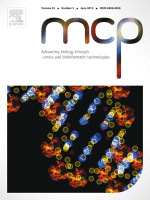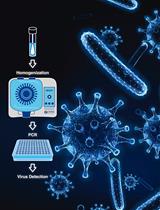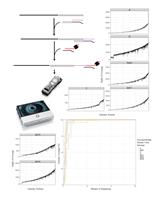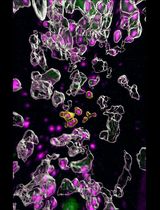- EN - English
- CN - 中文
RETRACTED: Paper Lateral Flow Biosensor for Nodavirus Reverse Transcribed RNA Detection
用于诺达病毒逆转录RNA检测的纸侧向流生物传感器
发布: 2020年08月05日第10卷第15期 DOI: 10.21769/BioProtoc.3711 浏览次数: 4018
评审: Alexandros AlexandratosTien Anh NgoRajesh Thippeshappa
Abstract
Paper nanobiosensors have been established as an excellent platform for analysis of veterinary and human pathogens causing various diseases. Especially, lateral flow assays or biosensors ideal for sensitive, rapid, robust and accurate analysis in laboratory setups and on-site analysis. Viral RNA detection is of great importance for public health as well as animal health protection. In that aspect, the present protocol focuses on the development of functionalized gold nanoparticle-based lateral flow biosensor for fish nervous necrosis virus (Nodavirus) nucleic acids detection. Total viral RNA, isolated from fish samples was subjected to reverse transcription PCR amplification and the amplification products were mixed with specific oligonucleotide probe. A red test line was formed when nodavirus product was present. The proposed assay has great implications on basic research since it eliminates the need for time-consuming, cumbersome electrophoresis protocols and could be adjusted for use on the site of fish culture by fish farmers. Disease monitoring by such bioanalytical platforms without time consuming and costly procedures would have great impact on the aquaculture and environmental safety.
Keywords: Lateral flow biosensor (侧向流生物传感器)Background
Point-of-care and/or on-site bioanalysis has been the ultimate goal of research efforts focusing on the well being of humans and animals. Sensing platforms based on paper substrates are very attractive as analytical platforms because they are functionalized easily, with great reproducibility and low fabrication costs. Paper-based analytical devices have been applied on the analysis of small molecules, proteins and all kinds of nucleic acids (Parolo and Merkoçi, 2013; Bahadir and Sezgintürk, 2016; Jiang et al., 2019). Lateral flow biosensors (LFBs) are prefabricated strips of materials with dry reagents and they are activated by fluid samples. They are designed for disposable single use where an on/off signal is sufficient (Posthuma-Trumpie et al., 2009). Lateral flow nanobiosensors incorporate nanoparticles and are optimal for rapid analysis in research laboratories, along with their potential for use on point-of-care. Gold nanoparticles, with size smaller than 100 nm, are mainly used as LFB labels due to their unique optical properties, i.e., vivid red color, easy surface functionalization with a variety of biomolecules, intense optical signal, high surface-to-volume ratio and exceptional chemical stability (Cheng et al., 2019; Posthuma-Trumpie et al., 2009).
In that frame, our research efforts are focused on the development of gold nanoparticle-based lateral flow biosensors for virus assessment. The present protocol was developed for fish nervous necrosis virus or nodavirus nucleic acids detection (Toubanaki et al., 2015), in order to increase the detection accuracy, simplify and speed up the total time of PCR-based analysis. In brief, total viral RNA, isolated from fish samples was subjected to reverse transcription PCR (RT-PCR) amplification. The PCR products were mixed with specific oligonucleotide probe and applied next to oligonucleotide conjugated gold nanoparticles (Au NPs). A red test line was formed when nodavirus product was present. The visual detection of the RT-PCR product was completed within 20 min. The present detection platform has been utilized in other pathogens detection (e.g., hepatitis C virus [Glynou et al., 2003]; bacterial infections [Kalogianni et al., 2007]; Leishmania parasite DNA [Toubanaki et al., 2016]) and could be adjusted for other pathogens detection with proper primers and probe design.
Materials and Reagents
- Materials
- 0.22 μm filter
- Pipettes tips: 0.5-10 μl, 10-200 μl (Greiner Bio-One, catalog numbers: 771291 , 739290 )
- Filtered tip racks 0.5-10 μl, 5-100 μl, 5-200 μl and tip racks 0.5-20 μl, 2-200 μl, 50-1,000 μl (Brand, catalog numbers: 732624 , 732630 , 732632 , 732124 , 732128 , 732132 )
- Siliconized tubes 1.7 ml (Sigma-Aldrich, catalog number: T3406 )
- Stainless steel beads 5 mm (Qiagen, catalog number: 69989 )
- 1.5 ml polypropylene tubes, attached flat-cap (Greiner Bio-One, catalog number: 616201 )
- 15 ml polypropylene tubes, screw cap (Greiner Bio-One, catalog number: 188271 )
- 50 ml polypropylene tubes, screw cap (Greiner Bio-One, catalog number: 227261 )
- Glass fiber pad (Millipore, catalog number: GFCP000800 ), store at RT
- Reagents
- Agarose (HT Biotechnology, catalog number: SB11a ), store at RT
- β-Mercaptoethanol (β-ME) (Sigma-Aldrich, catalog number: 444203 ), store at RT
- Cellulose fiber pad (Millipore, catalog number: CFSPOO1700 ), store at RT
- Dextran cross-linked G-25 (Sigma-Aldrich, catalog number: 92639 ), store at RT
- dNTPs: dATP, dTTP, dCTP, dGTP (HT Biotechnology, catalog number: SB23 ), store at -20 °C
- Ethanol absolute (Sigma-Aldrich, catalog number: 32205-M ), store at RT
- Ethidium bromide (Sigma-Aldrich, catalog number: E1510 ), store at RT
- Glycerol (Applichem, catalog number: A2926 ,1000), store at RT
- Gold nanoparticles 40 nm (Sigma-Aldrich, catalog number: 741981 ), store at 4 °C
- GoTaq Flexi DNA polymerase (Promega, catalog number: M8301 ), store at -20 °C
- Hydrochloric acid (HCl) solution, 1 M (Sigma-Aldrich, catalog number: 150696 ), store at RT
- Methanol (Sigma-Aldrich, catalog number: 322415 ), store at RT
- Nitrocellulose membrane (Millipore, catalog number: HF180MC100 ), store at RT
- N-methylmaleimide (Sigma-Aldrich, catalog number: 389412 ), store at RT
- Oligonucleotides (Table 1): dA20, SH-dT30, UpNdv_B upstream primer, DpNdv downstream primer, probe_Ndv (VBC-Biotech, custom order), store at -20 °C after reconstitution
Table 1. Oligonucleotides used in the present protocol
- PCR-grade water (Jena Bioscience, catalog number: PCR-258-500 ), store at 4 °C
- Pyridine (Sigma-Aldrich, catalog number: 270970 ), store at RT
- RNaseOUTTM Recombinant Ribonuclease Inhibitor (Invitrogen, catalog number: 10777019 ), store at -20 °C
- RNeasy Mini kit (Qiagen, catalog number: 74104 ), store at RT
- Sodium chloride (NaCl) (Applichem, catalog number: 381659 ), store at RT
- Sodium Dodecyl Sulfate (SDS) (Sigma-Aldrich, catalog number: L4509 ), store at RT
- Sodium hydroxide (NaOH) solution, 1 M (Sigma-Aldrich, catalog number: 79724 ), store at RT
- Streptavidin from Streptomyces avidinii (Sigma-Aldrich, catalog number: S4762 ), store at -20 °C
- Sucrose (Sigma-Aldrich, catalog number: S0389 ), store at RT
- SuperScript II (Invitrogen, catalog number: 18064014 ), store at -20 °C
- Terminal deoxynucleotidyl transferase (New England Biolabs, catalog number: M0315S ), store at -20 °C
- Tween-20 (Sigma-Aldrich, catalog number: P9416 ), store at RT
- φX174 DNA HaeIII digest DNA (New England Biolabs, catalog number: N3026 S ), store at -20 °C
- Potassium chloride (KCl) (Sigma-Aldrich, catalog number: 746336 ), store at RT
- Sodium phosphate dibasic (Na2HPO4) (Sigma-Aldrich, catalog number: 795410 ), store at RT
- Potassium phosphate monobasic (KH2PO4) (Sigma-Aldrich, catalog number: 795488 ), store at RT
- Phosphate-buffered saline, 10× (PBS, pH 7.4) (see Recipes)
- LFB developing solution (see Recipes)
Equipment
- -20 °C freezer
- -80 °C freezer
- Desktop scanner (HP, HP Scanjet G4050)
- Dosage syringe 100 µl for Linomat (Camag, catalog number: 695.0014 )
- Microcentrifuge (Heraeus, Sepatech)
- Paper cutter Guillotine (Plaisio Office Supplies, catalog number: 800882 )
- Sonicator bath Bransonic (Sigma-Aldrich, catalog number: Z305359EU )
- PCR Workstation (Euroclone-Bioair, Aura)
- pH Meter (Thermo Fisher Scientific, catalog number: 13-644-928 )
- Pipettes:
Nichipet EXII 0.5-10 μl and 20-200 μl (Nichiryo, catalog numbers: NPX-10 , NPX-200 )
Transferpette S 0.5-10 μl, 10-100 μl, 20-200 μl and 100-1,000 μl (Brand, catalog numbers: 705870 , 705874 , 705878 , 705880 ) - Scissors and forceps, kept sterile with 70% ethanol
- Spectrophotometer (Thermo Fisher Scientific, model: NanoDropTM 1000, catalog number: ND-1000 )
- Thermal cycler (Applied Biosystems, GeneAmp PCR System 9700)
- Tissue homogenizer (TissueLyser LT) (Qiagen, catalog number: 85600 )
- Tissue homogenizer adapter (TissueLyser LT Adapter 12-Tube) (Qiagen, catalog number: 69980 )
- TLC applicator (Camag, Linomat, catalog number: 0 22.7808 )
- Vortex (Velp Scientifica, mdoel: Vortex ZX3)
- Water bath (LabTech, model: LSB-015S )
- Water distiller (Sartorius, model: Arium® Comfort I, catalog number: H2O-I-1-UV-T )
Software
- Adobe PhotoShop (Adobe Systems)
- CAMAG® HPTLC Software visionCATS Basic Version (Camag, catalog number: 028.0000)
- NanoDrop 1000 software (Thermo Fisher Scientific, NanoDrop ND-1000 )
- ImageJ software (National Institutes of Health (NIH), https://imagej.net/Welcome)
- Microsoft® Office Excel 2010 (Microsoft)
Procedure
文章信息
版权信息
© 2020 The Authors; exclusive licensee Bio-protocol LLC.
如何引用
Toubanaki, D. K. and Karagouni, E. (2020). RETRACTED: Paper Lateral Flow Biosensor for Nodavirus Reverse Transcribed RNA Detection. Bio-protocol 10(15): e3711. DOI: 10.21769/BioProtoc.3711.
分类
微生物学 > 病原体检测 > 生物传感器
分子生物学 > RNA > RNA 检测
分子生物学 > 纳米颗粒 > 传感器
您对这篇实验方法有问题吗?
在此处发布您的问题,我们将邀请本文作者来回答。同时,我们会将您的问题发布到Bio-protocol Exchange,以便寻求社区成员的帮助。
提问指南
+ 问题描述
写下详细的问题描述,包括所有有助于他人回答您问题的信息(例如实验过程、条件和相关图像等)。
Share
Bluesky
X
Copy link













